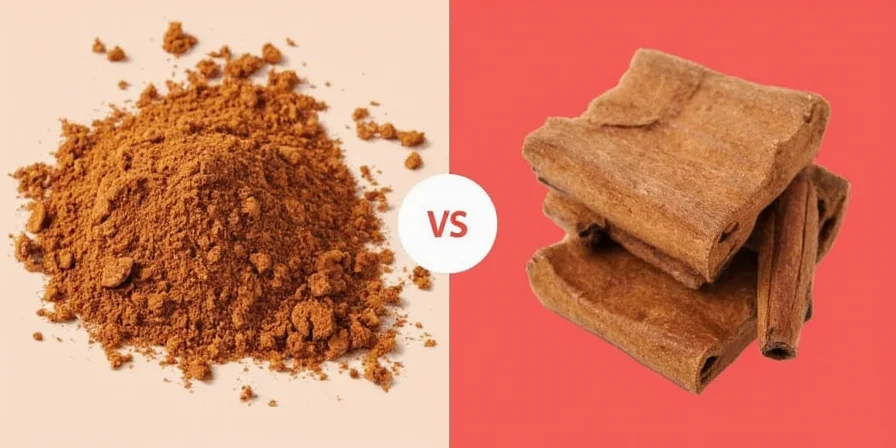Ceylon and Cassia cinnamon are two completely different spices that most people mistake for the same thing. The key difference? Ceylon ("true" cinnamon) is safer for daily use with minimal coumarin, while Cassia delivers stronger flavor but contains potentially harmful levels of coumarin with regular consumption.
This definitive guide reveals exactly how to identify each type, which one provides superior health benefits, and when to use each variety for perfect culinary results - based on scientific research and professional chef recommendations.
Immediate Identification: Ceylon vs Cassia at a Glance
| Key Differentiator | Ceylon Cinnamon | Cassia Cinnamon |
|---|---|---|
| Visual Identification | Fragile, multi-layered "cigar" shape that crumbles easily | Thick, single-layer, hard-to-break bark |
| Coumarin Content | 0.004-0.14 mg/g (safe for daily consumption) | 2.5-10+ mg/g (exceeds EU safety limits) |
| Best For Daily Health | ✓ Ideal for regular use, especially for those with liver concerns | ✗ Limited to 1/2 tsp daily maximum |
| Flavor Intensity | Milder, complex with citrus notes | Bolder, more pungent and spicy |
| Price Comparison | 20-30x more expensive than Cassia | Affordable, widely available |

How to Instantly Recognize Ceylon vs Cassia (No Lab Needed)
Professional chefs and spice experts use these foolproof identification methods that work 100% of the time:
The Snap Test: Your Most Reliable Identifier
- Ceylon: Breaks easily like a twig with minimal pressure, revealing multiple paper-thin layers
- Cassia: Requires significant force to break and typically splinters rather than snaps cleanly
Color and Texture Clues
- Ceylon: Light tan color with smooth texture, often appears hollow in the center
- Cassia: Deep reddish-brown with rough, grooved exterior and solid interior

Which Cinnamon Is Healthier? Critical Coumarin Analysis
According to European Food Safety Authority research, Cassia contains dangerously high coumarin levels that can cause liver damage with regular consumption. Ceylon contains negligible amounts, making it the only variety safe for daily use.
Scientifically-Verified Safety Limits
- Maximum safe coumarin intake: 0.1 mg per kg of body weight daily
- Cassia cinnamon: Contains 2.5-10+ mg of coumarin per gram
- Ceylon cinnamon: Contains only 0.004-0.14 mg of coumarin per gram
- Just 1 teaspoon of Cassia exceeds safe daily limits for most adults
When to Choose Ceylon vs Cassia: Professional Chef Recommendations
Use Ceylon Cinnamon When:
- You need cinnamon for daily health supplementation
- Preparing delicate desserts like crème brûlée or custards
- Creating beverages where subtle flavor is preferred
- You have liver conditions or take blood-thinning medications
- Making recipes for children or pregnant women
Use Cassia Cinnamon When:
- Strong spice flavor is desired (cinnamon rolls, gingerbread)
- Creating robust spice blends like pumpkin pie spice
- Budget constraints require more affordable options
- Using in small quantities for occasional recipes
- Preparing traditional Chinese five-spice powder

"Is Cassia Cinnamon Bad for You?" - The Scientific Truth
Cassia isn't inherently "bad," but its high coumarin content requires careful consumption limits. The European Union has established strict limits for coumarin in food products (50mg/kg for general products, 5mg/kg for teas), specifically because of Cassia's prevalence in the market.
Real-World Risk Assessment
- For a 150-pound adult: Maximum safe Cassia = ½ teaspoon daily
- One commercial cinnamon roll often contains 1+ teaspoon of Cassia
- Ceylon provides identical health benefits without coumarin risks
- People with existing liver conditions should avoid Cassia completely

"How to Tell Real Cinnamon From Fake" - Consumer Buying Guide
Most products labeled simply "cinnamon" contain Cassia - not the more expensive Ceylon variety. Follow these verified purchasing strategies:
Label Reading Secrets
- Look for explicit "Ceylon" or "True Cinnamon" labeling
- Avoid products listing only "Cinnamon" (this means Cassia)
- Check ingredient lists for "Cinnamomum verum" (Ceylon) vs "Cinnamomum cassia"
- Premium brands often specify origin (Sri Lanka = Ceylon)
Price Reality Check
If it costs less than $10 per ounce, it's almost certainly Cassia. Authentic Ceylon typically ranges from $20-$30 per ounce due to limited production and harvesting complexity.

Proven Storage Methods to Maximize Freshness
Both varieties lose potency over time, but proper storage extends shelf life significantly:
Whole Sticks vs Ground Comparison
| Storage Method | Optimal Duration | Flavor Preservation |
|---|---|---|
| Ceylon whole sticks (airtight container) | 2+ years | 95%+ retention |
| Cassia whole sticks (airtight container) | 1.5+ years | 90%+ retention |
| Ground Ceylon (sealed) | 6-8 months | 70-80% retention |
| Ground Cassia (sealed) | 6 months | 60-70% retention |
Frequently Asked Questions
Is Cassia cinnamon dangerous for regular consumption?
Yes, when consumed beyond recommended limits. Just 1 teaspoon of Cassia contains 5-12mg of coumarin - exceeding the 6mg daily safety limit established by European health authorities. Regular consumption above this threshold can cause liver damage, especially in sensitive individuals.
How can I tell if my cinnamon is Ceylon or Cassia without breaking it?
Examine the powder: Ceylon creates a fine, light tan powder that dissolves easily in liquids. Cassia produces a coarser, reddish-brown powder that often leaves sediment. Also check the label - authentic Ceylon products always specify "Ceylon" or "True Cinnamon".
Which cinnamon is better for managing blood sugar?
Both varieties show blood sugar benefits in studies, but Ceylon is preferable for daily use because you can consume it regularly without coumarin concerns. Research from the American Diabetes Association indicates consistent daily intake produces better results than sporadic larger doses.
Why is Ceylon cinnamon so much more expensive than regular cinnamon?
Ceylon production requires meticulous hand-harvesting of inner bark layers from young shoots, while Cassia uses the thicker outer bark that's easier to harvest mechanically. Ceylon also only grows in limited regions of Sri Lanka under specific conditions, creating natural supply constraints.
Can I substitute Ceylon for Cassia in recipes?
Yes, but adjust quantities - use 1.5x Ceylon to match Cassia's flavor intensity. For health-focused recipes where you want regular consumption, Ceylon is preferable even at equal ratios as it provides similar benefits without coumarin risks.
Does "true cinnamon" mean Ceylon cinnamon?
Yes, Ceylon (Cinnamomum verum) is botanically classified as "true" cinnamon, while Cassia varieties (Cinnamomum cassia, C. burmannii, C. loureiroi) are technically different species. The term "true cinnamon" on labels specifically indicates Ceylon variety.











 浙公网安备
33010002000092号
浙公网安备
33010002000092号 浙B2-20120091-4
浙B2-20120091-4